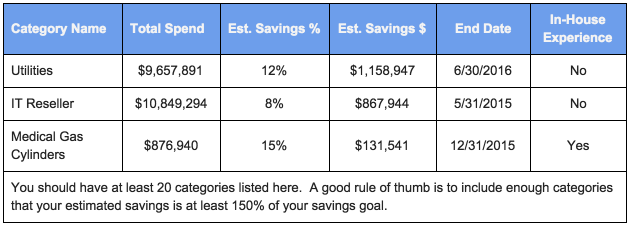Since I have the pleasure of meeting with a few different healthcare executives each week regarding purchased services, I have the unique opportunity to hear what’s going on in the real world. One of the biggest reasons our company is being brought in is due to a new trend VPs and Directors of Supply Chain/Procurement are facing. They are being tasked with finding millions of dollars of savings within their purchased services categories.
Not only that, the C-suite (and most likely the board) is not allowing these VPs and Directors to simply say, Yes, sir/ma’am and then scramble to figure out where to find the savings later on. They are requiring them to build a specific work plan on how they are going to achieve it.
Gone are the days of squeaking by at the end of the year hoping for something to fall into your lap. Your senior executives are putting on their MBA hats and requiring their teams to submit executive level business plans (or work plans) because they have heard over the past few years that there is a gold mine within their purchased services categories and they are right.
So, where are you going to start? Do you have a comprehensive list of all of the purchased services categories within your health system from which to choose? You are going to need to find at least 10-12 categories per year to hit the, most likely, huge savings goal handed down to you and your team. How are you going to decide where to allocate your limited resources to get the biggest bang for your buck?
The Consultant
Most likely you are going to need some help because you probably have a very short deadline. Your first instinct might be that you need to hire an expensive consultant to complete a purchased services assessment. This definitely would work if you select the right one, but it will cost you between $50,000-$150,000 depending on your size and will take two to three months to complete.
Do you have that extra cash in your budget and the required turnaround time it will take? How comfortable will you be with these results? You know they are just going to hand you a notebook of savings opportunities but you will have to pay them a contingency fee somewhere between 25%-35% of the savings if you hire them to actually implement any savings initiatives. That can cost you millions, but at least the work would get done. But how does this process look to your senior team? It will most likely look like you kicked the can to a consultant because you didn’t know how to complete the task on your own. That’s not good.
I’m not saying that it’s bad to hire a consultant to complete a purchased services assessment if that was part of the plan to begin with. I’m saying that it looks better and is more empowering to find this savings on your own. You will need data and technology to complete this task on your own, but you would have needed to send this same data to a consultant, so don’t worry about that part. The key here is the technology.
What You Can Do Now
You are going to need a tool that can take in that raw data file, clean it up, categorize all of your vendors appropriately, identify potential savings opportunities and then help you track these savings throughout the year. Again, you might be able to do this on your own using Excel if you trust your general ledger categories within your accounts payable software, have massive amounts of extra analyst time, and the expertise to know how to accurately categorize every vendor and all of their transactions across all of your locations.
Whichever way you chose, either using the newest technology or doing it on your own, you have to find those savings opportunities fast. Even if you already know of a few categories you want to start with, do you know what the industry’s average savings is or what the average spend per bed is for organizations similar to you?
These are the questions that your senior executives are going to ask you, and if they are not, you should be worried (more on that later). So are you confident in yourself and your team to submit a multi-year purchased services work plan on your own? You most likely use technology to help you find savings in medical and physician preference products. Why not see what is out there to help you in purchased services?
Here are some action steps you can take to get started:
-
Use the spreadsheet you completed in our last blog post.
-
Add two columns to it: Est. Savings % and Est. Savings $.
-
Insert the average industry savings percentage for each category or use your own expected savings percentage. (Contact us if you need help here.)
-
Prioritize your categories based on the estimated savings dollars.
-
Build your internal work plan based on experience and availability.
-
Decide if you need a consultant to help reach your savings goals with the categories your team cannot handle at this time.
Your spreadsheet will look something like this:


